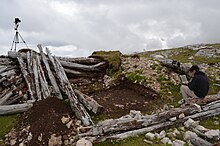
Battlefield archaeology is a sub-discipline of archaeology which studies the material remains and topography of a battlefield to understand a conflict.[1] Archaeological battlefields consist of skirmishes, sieges, camps, and training sites. The study of the relationships and contexts of the material by-products of war give an alternate account to the version recorded in a history book, poem, or witness account, which may be constructed though bias, or may present only a limited perspective of the events. Examination of these locations gives insight to what tactics were being used, weapon modifications, and battle formations.[2] It is not considered distinct from Military archaeology or Recceology (i.e., the recovery of surface finds and non-invasive site surveying).
Whilst the battlefield is a contemporary concept, the archaeology of battlefields incorporates the study of both ancient and modern military technologies, features and conflicts. It may also incorporate events such as civil unrest, including public demonstrations and riots. The discipline, therefore, applies the approaches and techniques of archaeology to military and civil conflict. Conflicts in the twentieth century in particular have been characterised by wars of ethnicity, nationality and identity, where civilians and civilian environments (i.e., domestic buildings, urban centres) have become involved in warfare, and are often inseparable from it.[3] This is also known as 'Total War', understood by the engagement of entire populations and economies within the sphere of warfare. The archaeology of contemporary conflict, therefore, is a 'total' project, considering the impact of conflict and modern weapons systems on civilian as well as military targets.
Common artifacts would be cannons and firearm fragments from a Revolutionary War battle. Data cannot be counted as evidence until a pattern is found. An example would be a unique looking bullet. If the artifact doesn't match any other data collected, the piece more than likely wasn't part of the conflict being studied.[2] Information is found through historical references, regional archaeologists, and previous studies.[1]
Prosecution of battlefield thieves rarely occurs. Most penalties do not include jail time but usually involve a confiscation of items or metal detectors. Laws have been passed to deter criminals, but looting still occurs. The National Historic Preservation Act (NHPA) was one such act, but lacks penalties needed to deter crime.[4]
- ^ a b "FAQs: Battlefield Archaeology". American Battlefield Trust. 2017-01-30. Retrieved 2020-04-20.
- ^ a b Sutherland, Tim (2017). Battlefield Archaeology: A Guide to the Archaeology of Conflict (PDF). BAJR.org.
- ^ Schofield et al. (2002) Pg. 2
- ^ Starbuck, David (September 15, 2012). The archaeology of Forts and Battlefields. University Press of Florida. p. 46. ISBN 978-0813044149.